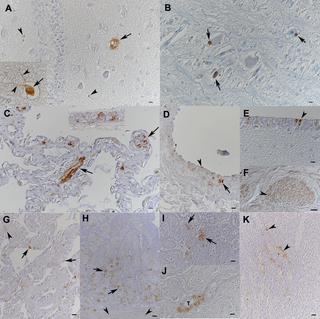PLoS Pathogens ( IF 5.5 ) Pub Date : 2018-11-14 , DOI: 10.1371/journal.ppat.1007415 Jussi Hepojoki 1, 2, 3 , Satu Hepojoki 1, 2 , Teemu Smura 1, 3 , Leonóra Szirovicza 1, 3 , Eva Dervas 2, 3 , Barbara Prähauser 2 , Lisbeth Nufer 2 , Elisabeth M Schraner 4 , Olli Vapalahti 1, 3, 5, 6 , Anja Kipar 2, 3, 5 , Udo Hetzel 2, 3, 5

|
The family Arenaviridae comprises three genera, Mammarenavirus, Reptarenavirus and the most recently added Hartmanivirus. Arenaviruses have a bisegmented genome with ambisense coding strategy. For mammarenaviruses and reptarenaviruses the L segment encodes the Z protein (ZP) and the RNA-dependent RNA polymerase, and the S segment encodes the glycoprotein precursor and the nucleoprotein. Herein we report the full length genome and characterization of Haartman Institute Snake virus-1 (HISV-1), the putative type species of hartmaniviruses. The L segment of HISV-1 lacks an open-reading frame for ZP, and our analysis of purified HISV-1 particles by SDS-PAGE and electron microscopy further support the lack of ZP. Since we originally identified HISV-1 in co-infection with a reptarenavirus, one could hypothesize that co-infecting reptarenavirus provides the ZP to complement HISV-1. However, we observed that co-infection does not markedly affect the amount of hartmanivirus or reptarenavirus RNA released from infected cells in vitro, indicating that HISV-1 does not benefit from reptarenavirus ZP. Furthermore, we succeeded in generating a pure HISV-1 isolate showing the virus to replicate without ZP. Immunofluorescence and ultrastructural studies demonstrate that, unlike reptarenaviruses, HISV-1 does not produce the intracellular inclusion bodies typical for the reptarenavirus-induced boid inclusion body disease (BIBD). While we observed HISV-1 to be slightly cytopathic for cultured boid cells, the histological and immunohistological investigation of HISV-positive snakes showed no evidence of a pathological effect. The histological analyses also revealed that hartmaniviruses, unlike reptarenaviruses, have a limited tissue tropism. By nucleic acid sequencing, de novo genome assembly, and phylogenetic analyses we identified additional four hartmanivirus species. Finally, we screened 71 individuals from a collection of snakes with BIBD by RT-PCR and found 44 to carry hartmaniviruses. These findings suggest that harmaniviruses are common in captive snake populations, but their relevance and pathogenic potential needs yet to be revealed.
中文翻译:

哈特曼研究所蛇病毒-1 (HISV-1) 和 HISV 样病毒的特征——沙粒病毒科哈特曼病毒属的代表
沙粒病毒科包括三个属:乳腺病毒属、爬虫病毒属和最近添加的哈特马尼病毒属。沙粒病毒具有双片段基因组和双义编码策略。对于哺乳动物病毒和蛇毒病毒,L 片段编码 Z 蛋白 (ZP) 和 RNA 依赖性 RNA 聚合酶,S 片段编码糖蛋白前体和核蛋白。在此,我们报告了哈特曼研究所蛇病毒 1 (HISV-1) 的全长基因组和特征,该病毒是哈特曼病毒的推定型种。HISV-1 的 L 片段缺乏 ZP 的开放阅读框,我们通过 SDS-PAGE 和电子显微镜对纯化的 HISV-1 颗粒进行的分析进一步支持 ZP 的缺乏。由于我们最初发现 HISV-1 与爬虫病毒共同感染,因此可以假设共同感染爬虫病毒提供了 ZP 来补充 HISV-1。然而,我们观察到,共感染并没有显着影响体外受感染细胞释放的哈特马尼病毒或爬虫病毒RNA的量,表明HISV-1并不能从爬虫病毒ZP中受益。此外,我们成功地产生了纯 HISV-1 分离株,表明该病毒无需 ZP 即可复制。免疫荧光和超微结构研究表明,与爬行病毒不同,HISV-1 不会产生爬行病毒诱导的 boid 包涵体病 (BIBD) 所特有的细胞内包涵体。虽然我们观察到 HISV-1 对培养的 boid 细胞有轻微的细胞病变,但对 HISV 阳性蛇的组织学和免疫组织学研究显示没有病理效应的证据。组织学分析还表明,与爬虫病毒不同,哈特马尼病毒具有有限的组织嗜性。通过核酸测序、从头基因组组装和系统发育分析,我们鉴定了另外四种哈特马尼病毒属。最后,我们通过 RT-PCR 从 BIBD 蛇群中筛选了 71 条蛇,发现 44 条蛇携带哈特马尼病毒。这些发现表明,哈马尼病毒在圈养蛇种群中很常见,但其相关性和致病潜力尚未揭示。











































 京公网安备 11010802027423号
京公网安备 11010802027423号